人教版(2019) 选择性必修第二册 Unit 5 First Aid Listening and Speaking课件(23张)
文档属性
| 名称 | 人教版(2019) 选择性必修第二册 Unit 5 First Aid Listening and Speaking课件(23张) | 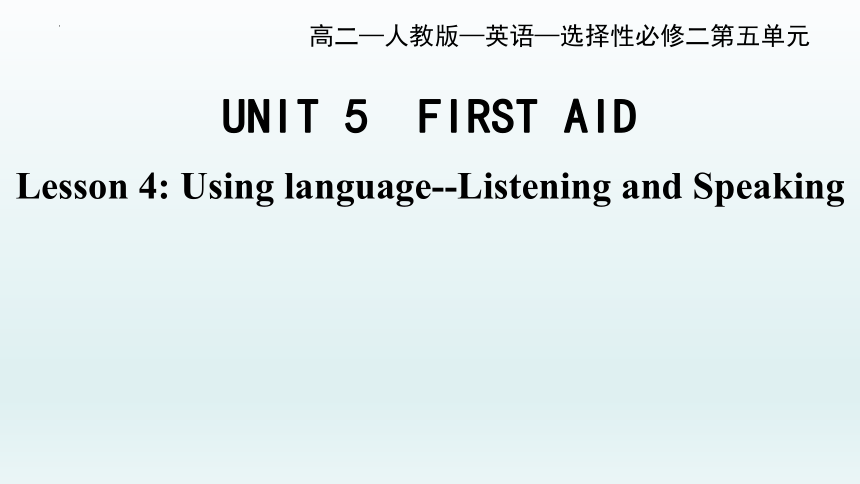 | |
| 格式 | pptx | ||
| 文件大小 | 10.0MB | ||
| 资源类型 | 教案 | ||
| 版本资源 | 人教版(2019) | ||
| 科目 | 英语 | ||
| 更新时间 | 2022-05-22 11:01:06 | ||
图片预览

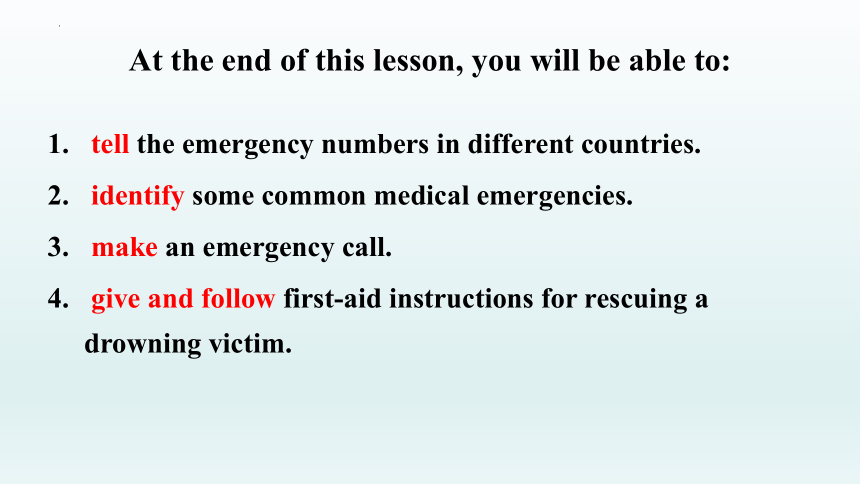

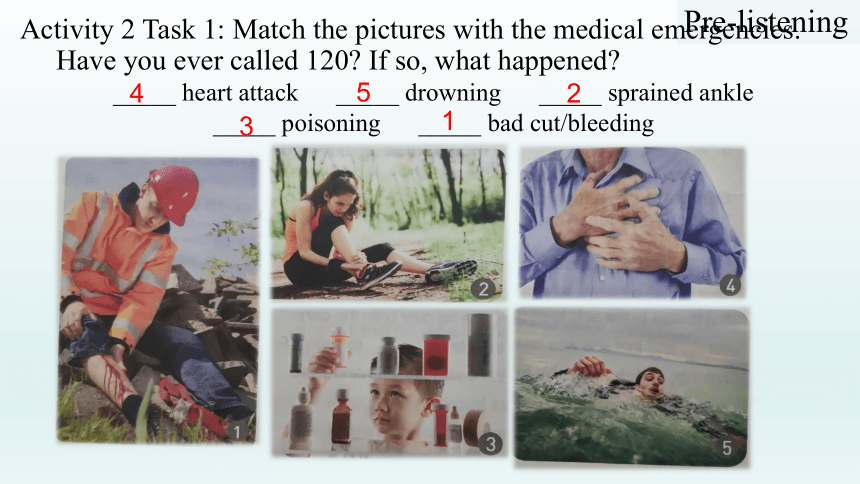
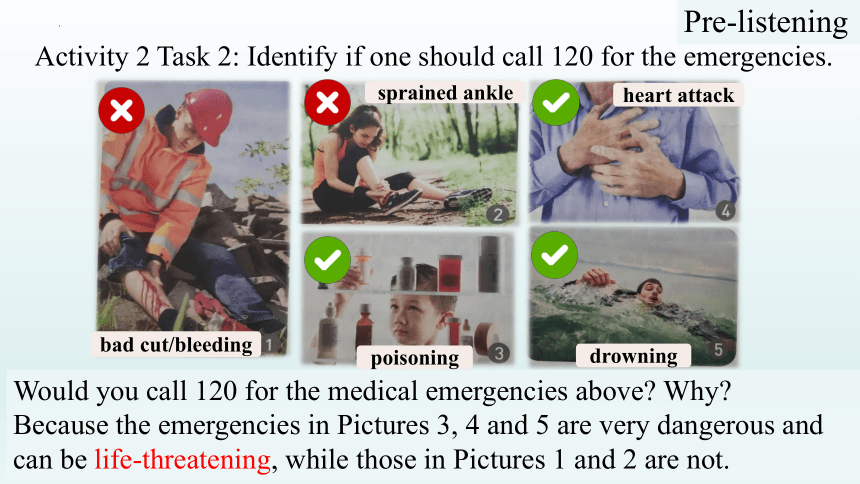
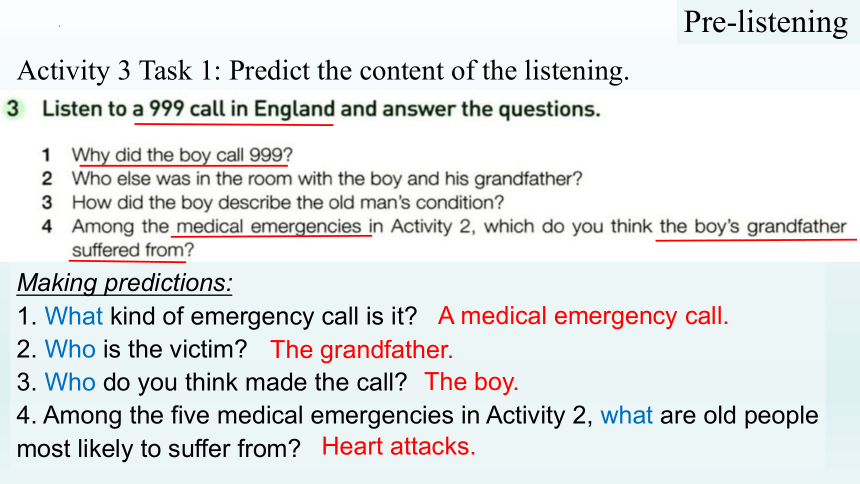



文档简介
(共23张PPT)
高二—人教版—英语—选择性必修二第五单元
UNIT 5 FIRST AID
Lesson 4: Using language--Listening and Speaking
At the end of this lesson, you will be able to:
tell the emergency numbers in different countries.
identify some common medical emergencies.
make an emergency call.
give and follow first-aid instructions for rescuing a drowning victim.
Activity 1:
Try to match the countries with the emergency numbers.
Australia -- ______
Canada -- ______
China -- ______
Japan -- ______
Most European contries -- ______
New Zealand -- ______
South Korea -- ______
the UK -- ______
the US -- ______
000
911
120
119
112
111
119
999
911
Pre-listening
119
112
120
111
000
911
999
Have you ever called 120 If so, what happened
Pre-listening
Activity 2 Task 1: Match the pictures with the medical emergencies.
_____ heart attack _____ drowning _____ sprained ankle
_____ poisoning _____ bad cut/bleeding
3
1
2
4
5
Pre-listening
Activity 2 Task 2: Identify if one should call 120 for the emergencies.
Would you call 120 for the medical emergencies above Why
Because the emergencies in Pictures 3, 4 and 5 are very dangerous and can be life-threatening, while those in Pictures 1 and 2 are not.
bad cut/bleeding
sprained ankle
poisoning
heart attack
drowning
Activity 3 Task 1: Predict the content of the listening.
Making predictions:
1. What kind of emergency call is it
2. Who is the victim
3. Who do you think made the call
4. Among the five medical emergencies in Activity 2, what are old people most likely to suffer from
A medical emergency call.
The grandfather.
The boy.
Heart attacks.
Pre-listening
Activity 3 Task 2: Listen to a 999 call in England and answer the questions.
1. Why did the boy call 999
2. Who else was in the room with the boy and his grandfather
3. How did the boy describe the old man's condition
4. Among the medical emergencies in Activity 2, which do you think the boy's grandfather suffered from
The boy's mother.
Because his grandfather was having a serious health problem and they needed an ambulance.
His breathing has gotten really bad. I think he’s dying.His face looks funny. He’s started to breathe again. His lips are blue. He’s making strange noises. He’s not breathing again. He’s not breathing anymore.
Perhaps a heart attack.
Listening
Observe: What sentence structure do these instructions have in common
The imperative: Verb + Object
Activity 4 Task 1:
Listen again. Number the following instructions the operator gave.
Listening
______ Press down, twice a second.
______ Check to see if there is food in his mouth.
______ If your mother needs a break, change places.
______ Put him on his back.
______ Remove any pillows.
______ Tell your mum to put her hand in the middle of his chest.
5
3
6
1
2
4
Operator: Hello, this is the ambulance.
Boy: Hi, it’s my grandfather…his breathing has gotten really bad. We need an ambulance!
Operator: OK. Could you tell me your address
Boy: 18 West Highgate.
Operator: And your phone number
Boy: Oh, it’s…it’s 655-212. Please hurry! I think he’s dying!
Operator: Now calm down and tell me what’s wrong.
Boy: His face looks funny... [Screaming. ] Granddad! Granddad! Keep breathing! Help, please!
Operator: Right. How old is he
Boy: He’s 68.
Operator: And are you with him now
Boy: Yes. Me and my mother.
Operator: I’ll tell you what to do. First, is he on his back
Boy: Yes, I just moved him on his back.
Operator: Next, remove any pillows.
Boy: OK. What next
Operator: Now look in his mouth. Any food there
Boy: No. Oh, he's started to breathe again.
Operator: So, he's breathing
Boy: Yes, but his lips are blue! He's making strange noises! Can you hurry!
Activity 4 Task 2: Read after the speakers and further analyse the features of an emergency call.
Listening
Operator: The ambulance is on the way. Is he conscious now
Boy: No. [Boy starts crying.] He's not breathing again!
Operator: Listen to me! Next, tell your mum to put her hand in the middle of his chest, and press Down.
Boy: Mum, put your hand in the middle of his chest and push down.
Operator: You need to do this quickly… twice per second.
Boy: Twice a second, Mum! Hurry! Oh, he's not breathing anymore!
Operator: Just be calm and do what I tell you. The ambulance is on the way. Press the chest twice a second. Keep doing it.
Boy: Keep doing it, Mum!
Operator: I know it's very tiring. If your mother needs a break, you should change places.
Boy: Please hurry up!... Oh, the ambulance is here! [Sound of a siren in the background.]
Operator: I can hear them. I can hear them.
Boy: Oh, thank you so much!
Activity 4 Task 2: Read after the speakers and further analyse the features of an emergency call.
Listening
Operator: Hello, this is the ambulance.
Boy: Hi, it’s my grandfather…his breathing has gotten really bad. We need an ambulance!
Operator: OK. Could you tell me your address
Boy: 18 West Highgate.
Operator: And your phone number
Boy: Oh, it’s…it’s 655-212. Please hurry! I think he’s dying!
Operator: Now calm down and tell me what’s wrong.
Boy: His face looks funny... [Screaming. ] Granddad! Granddad! Keep breathing! Help, please!
Operator: Right. How old is he
Boy: He’s 68.
Operator: And are you with him now
Boy: Yes. Me and my mother.
Operator: I’ll tell you what to do. First, is he on his back
Boy: Yes, I just moved him on his back.
Operator: Next, remove any pillows.
Boy: OK. What next
Operator: Now look in his mouth. Any food there
Boy: No. Oh, he's started to breathe again.
Operator: So, he's breathing
Boy: Yes, but his lips are blue! He's making strange noises! Can you hurry!
location and phone number
descriptions of the symptoms
Activity 4 Task 2: Read after the speakers and further analyse the features of an emergency call.
Listening
adverbs of sequence
Operator: The ambulance is on the way. Is he conscious now
Boy: No. [Boy starts crying.] He's not breathing again!
Operator: Listen to me! Next, tell your mum to put her hand in the middle of his chest, and press Down.
Boy: Mum, put your hand in the middle of his chest and push down.
Operator: You need to do this quickly… twice per second.
Boy: Twice a second, Mum! Hurry! Oh, he's not breathing anymore!
Operator: Just be calm and do what I tell you. The ambulance is on the way. Press the chest twice a second. Keep doing it.
Boy: Keep doing it, Mum!
Operator: I know it's very tiring. If your mother needs a break, you should change places.
Boy: Please hurry up!... Oh, the ambulance is here! [Sound of a siren in the background.]
Operator: I can hear them. I can hear them.
Boy: Oh, thank you so much!
Activity 4 Task 2: Read after the speakers and further analyse the features of an emergency call.
Listening
adverbs of sequence
Activity 4:
Listening
Follow instructions
When giving commands, people usually use the imperative. It’s simple and clear. To help the listeners follow what to do next, they use words such as first, next, then, after that, and finally. When listening to instructions in English, you should:
listen carefully and don’t panic.
follow the order of the instructions given to you.
answer any questions simply and directly when asked.
v.(使)惊慌;n.惊恐,惊慌
Speaking
Activity 5: Try to answer the following questions.
1. How did the operator keep the boy calm
By telling him to calm down and calmly asking him questions.
2. What did the operator do to make this call a success
She asked only the questions necessary to clearly find out the problem, and then she provided short and clear instructions as to what to do.
3. What do you think happened after the ambulance arrived
The doctors continued to provide CPR, took some blood pressure tests and temperature checking, while they transported him to the hospital.
Activity 6: Try to describe what is going on in each picture.
Speaking
Activity 6: Try to describe what is going on in each picture.
Speaking
Picture 1: lay the victim on his back
pat his shoulders
check for a response
Picture 2: call for an ambulance
Picture 3: check to see if he is breathing
Activity 6: Try to describe what is going on in each picture.
Speaking
Picture 4: lift up his chin
remove any grass or sand from his mouth
Picture 5: perform mouth-to-mouth rescue breathing
cover his mouth
blow air in
Picture 6: perform CPR
push down on the centre of his chest
Speaking
Activity 7:
Make a telephone call to your friend and role-play an emergency call with him or her. One of you will be the friend of a drowning victim (Student A), and the other will be a telephone operator (Student B) giving first-aid instructions. Use the pictures and useful expressions you have learnt in this lesson to help you.
Key points:
location and telephone number, description of the symptoms, giving instructions by using the imperative and adverbs for sequence
SAMPLE CONVERSATION
[ Recorded by Jiang Jinxing(江锦星) and Chen Yanming(陈彦鸣) from Guangdong Guangya High School ]
Speaking
O: Hello, this is emergency.
B: Hi, it's my friend. We are at the swimming pool and I think he's drowning.
We need an ambulance!
O: OK. Could you tell me your address
B: We are at the pond in Zhongshan Park.
O: And your phone number
B: Oh, it's... it's ×××-××××-××××. Please hurry! I think he's dying!
O: And are you with him now
B: Yes.
O: I'll tell you what to do. First, is he on his back
B: No, he's on his side.
O: Well, you'll need to roll him over then. Can you do that
B: OK. What next
O: Now check for a response. When you call to him, does he answer
B: No!
O: So, is he breathing
O = Operator B=Boy
B: No!
O: Does he have a pulse Is his heart beating
B: Let me check ... no!
O: Listen to me! Turn his head to the side, and then put your finger in his mouth to
make sure that there is nothing in it.
B: OK ... I've done that.
O: Now turn his head back up, and lift his chin back.
B: Yes, OK.
O: Just be calm and do what I tell you next. The ambulance is on the way. Breathe
into his moth until his chest rises. Do this twice.
B: OK ... now what
O: Now push down on the middle of his chest really hard and really fast. Every
thirty pushes, stop and give him two more breaths.
B: That's it
O: Yes, keep doing this until the ambulance arrives. And don't hang up the phone!
I'll be right here if you need more help. The ambulance is on its way.
B: OK!
SAMPLE CONVERSATION
[ Recorded by Jiang Jinxing(江锦星) and Chen Yanming(陈彦鸣) from Guangdong Guangya High School ]
Speaking
O = Operator B=Boy
What we have learned today
The emergency numbers in different countries.
The names of some common medical emergencies.
How to make an emergency call.
How to give and follow first-aid instructions for rescuing a drowning victim.
Review the medical emergencies we have learnt in class and the first-aid procedures to save a drowning victim.
Finish Exercise 1 on P89.
Search for more first-aid treatments online.
Homework
Thank you for watching!
高二—人教版—英语—选择性必修二第五单元
UNIT 5 FIRST AID
Lesson 4: Using language--Listening and Speaking
At the end of this lesson, you will be able to:
tell the emergency numbers in different countries.
identify some common medical emergencies.
make an emergency call.
give and follow first-aid instructions for rescuing a drowning victim.
Activity 1:
Try to match the countries with the emergency numbers.
Australia -- ______
Canada -- ______
China -- ______
Japan -- ______
Most European contries -- ______
New Zealand -- ______
South Korea -- ______
the UK -- ______
the US -- ______
000
911
120
119
112
111
119
999
911
Pre-listening
119
112
120
111
000
911
999
Have you ever called 120 If so, what happened
Pre-listening
Activity 2 Task 1: Match the pictures with the medical emergencies.
_____ heart attack _____ drowning _____ sprained ankle
_____ poisoning _____ bad cut/bleeding
3
1
2
4
5
Pre-listening
Activity 2 Task 2: Identify if one should call 120 for the emergencies.
Would you call 120 for the medical emergencies above Why
Because the emergencies in Pictures 3, 4 and 5 are very dangerous and can be life-threatening, while those in Pictures 1 and 2 are not.
bad cut/bleeding
sprained ankle
poisoning
heart attack
drowning
Activity 3 Task 1: Predict the content of the listening.
Making predictions:
1. What kind of emergency call is it
2. Who is the victim
3. Who do you think made the call
4. Among the five medical emergencies in Activity 2, what are old people most likely to suffer from
A medical emergency call.
The grandfather.
The boy.
Heart attacks.
Pre-listening
Activity 3 Task 2: Listen to a 999 call in England and answer the questions.
1. Why did the boy call 999
2. Who else was in the room with the boy and his grandfather
3. How did the boy describe the old man's condition
4. Among the medical emergencies in Activity 2, which do you think the boy's grandfather suffered from
The boy's mother.
Because his grandfather was having a serious health problem and they needed an ambulance.
His breathing has gotten really bad. I think he’s dying.His face looks funny. He’s started to breathe again. His lips are blue. He’s making strange noises. He’s not breathing again. He’s not breathing anymore.
Perhaps a heart attack.
Listening
Observe: What sentence structure do these instructions have in common
The imperative: Verb + Object
Activity 4 Task 1:
Listen again. Number the following instructions the operator gave.
Listening
______ Press down, twice a second.
______ Check to see if there is food in his mouth.
______ If your mother needs a break, change places.
______ Put him on his back.
______ Remove any pillows.
______ Tell your mum to put her hand in the middle of his chest.
5
3
6
1
2
4
Operator: Hello, this is the ambulance.
Boy: Hi, it’s my grandfather…his breathing has gotten really bad. We need an ambulance!
Operator: OK. Could you tell me your address
Boy: 18 West Highgate.
Operator: And your phone number
Boy: Oh, it’s…it’s 655-212. Please hurry! I think he’s dying!
Operator: Now calm down and tell me what’s wrong.
Boy: His face looks funny... [Screaming. ] Granddad! Granddad! Keep breathing! Help, please!
Operator: Right. How old is he
Boy: He’s 68.
Operator: And are you with him now
Boy: Yes. Me and my mother.
Operator: I’ll tell you what to do. First, is he on his back
Boy: Yes, I just moved him on his back.
Operator: Next, remove any pillows.
Boy: OK. What next
Operator: Now look in his mouth. Any food there
Boy: No. Oh, he's started to breathe again.
Operator: So, he's breathing
Boy: Yes, but his lips are blue! He's making strange noises! Can you hurry!
Activity 4 Task 2: Read after the speakers and further analyse the features of an emergency call.
Listening
Operator: The ambulance is on the way. Is he conscious now
Boy: No. [Boy starts crying.] He's not breathing again!
Operator: Listen to me! Next, tell your mum to put her hand in the middle of his chest, and press Down.
Boy: Mum, put your hand in the middle of his chest and push down.
Operator: You need to do this quickly… twice per second.
Boy: Twice a second, Mum! Hurry! Oh, he's not breathing anymore!
Operator: Just be calm and do what I tell you. The ambulance is on the way. Press the chest twice a second. Keep doing it.
Boy: Keep doing it, Mum!
Operator: I know it's very tiring. If your mother needs a break, you should change places.
Boy: Please hurry up!... Oh, the ambulance is here! [Sound of a siren in the background.]
Operator: I can hear them. I can hear them.
Boy: Oh, thank you so much!
Activity 4 Task 2: Read after the speakers and further analyse the features of an emergency call.
Listening
Operator: Hello, this is the ambulance.
Boy: Hi, it’s my grandfather…his breathing has gotten really bad. We need an ambulance!
Operator: OK. Could you tell me your address
Boy: 18 West Highgate.
Operator: And your phone number
Boy: Oh, it’s…it’s 655-212. Please hurry! I think he’s dying!
Operator: Now calm down and tell me what’s wrong.
Boy: His face looks funny... [Screaming. ] Granddad! Granddad! Keep breathing! Help, please!
Operator: Right. How old is he
Boy: He’s 68.
Operator: And are you with him now
Boy: Yes. Me and my mother.
Operator: I’ll tell you what to do. First, is he on his back
Boy: Yes, I just moved him on his back.
Operator: Next, remove any pillows.
Boy: OK. What next
Operator: Now look in his mouth. Any food there
Boy: No. Oh, he's started to breathe again.
Operator: So, he's breathing
Boy: Yes, but his lips are blue! He's making strange noises! Can you hurry!
location and phone number
descriptions of the symptoms
Activity 4 Task 2: Read after the speakers and further analyse the features of an emergency call.
Listening
adverbs of sequence
Operator: The ambulance is on the way. Is he conscious now
Boy: No. [Boy starts crying.] He's not breathing again!
Operator: Listen to me! Next, tell your mum to put her hand in the middle of his chest, and press Down.
Boy: Mum, put your hand in the middle of his chest and push down.
Operator: You need to do this quickly… twice per second.
Boy: Twice a second, Mum! Hurry! Oh, he's not breathing anymore!
Operator: Just be calm and do what I tell you. The ambulance is on the way. Press the chest twice a second. Keep doing it.
Boy: Keep doing it, Mum!
Operator: I know it's very tiring. If your mother needs a break, you should change places.
Boy: Please hurry up!... Oh, the ambulance is here! [Sound of a siren in the background.]
Operator: I can hear them. I can hear them.
Boy: Oh, thank you so much!
Activity 4 Task 2: Read after the speakers and further analyse the features of an emergency call.
Listening
adverbs of sequence
Activity 4:
Listening
Follow instructions
When giving commands, people usually use the imperative. It’s simple and clear. To help the listeners follow what to do next, they use words such as first, next, then, after that, and finally. When listening to instructions in English, you should:
listen carefully and don’t panic.
follow the order of the instructions given to you.
answer any questions simply and directly when asked.
v.(使)惊慌;n.惊恐,惊慌
Speaking
Activity 5: Try to answer the following questions.
1. How did the operator keep the boy calm
By telling him to calm down and calmly asking him questions.
2. What did the operator do to make this call a success
She asked only the questions necessary to clearly find out the problem, and then she provided short and clear instructions as to what to do.
3. What do you think happened after the ambulance arrived
The doctors continued to provide CPR, took some blood pressure tests and temperature checking, while they transported him to the hospital.
Activity 6: Try to describe what is going on in each picture.
Speaking
Activity 6: Try to describe what is going on in each picture.
Speaking
Picture 1: lay the victim on his back
pat his shoulders
check for a response
Picture 2: call for an ambulance
Picture 3: check to see if he is breathing
Activity 6: Try to describe what is going on in each picture.
Speaking
Picture 4: lift up his chin
remove any grass or sand from his mouth
Picture 5: perform mouth-to-mouth rescue breathing
cover his mouth
blow air in
Picture 6: perform CPR
push down on the centre of his chest
Speaking
Activity 7:
Make a telephone call to your friend and role-play an emergency call with him or her. One of you will be the friend of a drowning victim (Student A), and the other will be a telephone operator (Student B) giving first-aid instructions. Use the pictures and useful expressions you have learnt in this lesson to help you.
Key points:
location and telephone number, description of the symptoms, giving instructions by using the imperative and adverbs for sequence
SAMPLE CONVERSATION
[ Recorded by Jiang Jinxing(江锦星) and Chen Yanming(陈彦鸣) from Guangdong Guangya High School ]
Speaking
O: Hello, this is emergency.
B: Hi, it's my friend. We are at the swimming pool and I think he's drowning.
We need an ambulance!
O: OK. Could you tell me your address
B: We are at the pond in Zhongshan Park.
O: And your phone number
B: Oh, it's... it's ×××-××××-××××. Please hurry! I think he's dying!
O: And are you with him now
B: Yes.
O: I'll tell you what to do. First, is he on his back
B: No, he's on his side.
O: Well, you'll need to roll him over then. Can you do that
B: OK. What next
O: Now check for a response. When you call to him, does he answer
B: No!
O: So, is he breathing
O = Operator B=Boy
B: No!
O: Does he have a pulse Is his heart beating
B: Let me check ... no!
O: Listen to me! Turn his head to the side, and then put your finger in his mouth to
make sure that there is nothing in it.
B: OK ... I've done that.
O: Now turn his head back up, and lift his chin back.
B: Yes, OK.
O: Just be calm and do what I tell you next. The ambulance is on the way. Breathe
into his moth until his chest rises. Do this twice.
B: OK ... now what
O: Now push down on the middle of his chest really hard and really fast. Every
thirty pushes, stop and give him two more breaths.
B: That's it
O: Yes, keep doing this until the ambulance arrives. And don't hang up the phone!
I'll be right here if you need more help. The ambulance is on its way.
B: OK!
SAMPLE CONVERSATION
[ Recorded by Jiang Jinxing(江锦星) and Chen Yanming(陈彦鸣) from Guangdong Guangya High School ]
Speaking
O = Operator B=Boy
What we have learned today
The emergency numbers in different countries.
The names of some common medical emergencies.
How to make an emergency call.
How to give and follow first-aid instructions for rescuing a drowning victim.
Review the medical emergencies we have learnt in class and the first-aid procedures to save a drowning victim.
Finish Exercise 1 on P89.
Search for more first-aid treatments online.
Homework
Thank you for watching!
